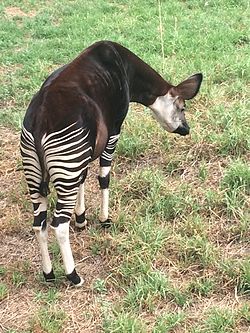Pretoria Zoo
| Pretoria Zoo | |
|---|---|
| File:NZG LOGO jpeg.jpg | |
 Okapi at Pretoria Zoo | |
 | |
| 25°44′18″S 28°11′21″E / 25.73833°S 28.18917°E | |
| Date opened | 21 October 1899 |
| Location | 232 Boom Street, Pretoria, South Africa |
| Land area | 85 hectares (210 acres)[1] |
| No. of animals | About 9,000[1] |
| No. of species | About 700[1] |
| Annual visitors | More than 600,000[1] |
| Memberships | WAZA, PAAZA, AKAA |
| Major exhibits | Aquarium, Aviary, Mammals, Reptiles |
| Website | www.nzg.ac.za |

The National Zoological Gardens of South Africa (also informally known as The Pretoria Zoo) is an 85-hectare (210-acre) zoo located in Pretoria, South Africa. It is the national zoo of South Africa, and was founded by J. W. B. Gunning in 1899. Pretoria Zoo is one of the eight largest zoos in the world[2] and one of the most highly-rated.[3]
History
The farm Klein Schoemansdal, the property of Z.A.R. president Stephanus Schoeman, was sold to Johannes Francois Celliers who renamed it Rus in Urbe. It was acquired by the state in 1895,[4] and the zoological gardens was established at the outbreak of the Second Boer War in 1899.[5] It became the official National Zoological Gardens in 1916.
Landscape
Half of the zoo is situated on relatively flat ground, while the other half is located on the slopes of a hill. The two areas are separated by the Apies River flowing through the zoo. Two bridges provide access over the river.
Infrastructure
Around 6 kilometres (3.7 mi) of pathways are laid out in the zoo. Golf carts are available for rent for those that prefer not to walk; most, but not all of the exhibits are accessible by golf cart.
A cable car links the top of the hill with a point close to the entrance at the bottom.
There are two restaurants located within the zoo and a picnic area on the banks of the Apies River.
A crafts market is located outside the zoo entrance.
Exhibits
| Group | Species[1] | Animals[1] |
|---|---|---|
| Mammals | 209 | 3117 |
| Birds | 202 | 1358 |
| Fish | 190 | 3871 |
| Invertebrates | 4 | 388 |
| Reptiles | 93 | 309 |
| Amphibians | 7 | 44 |
| Total | 705 | 9087 |
Proceeding from the entrance a visitor encounters a walk-through aviary, enclosures for chimpanzees, waterbirds and lemurs, a bird of prey aviary, further bird enclosures and the baboon and monkey enclosures along the western boundary.
At the centre of the zoo large sections are set aside for the African savannah waterhole and a set of large enclosures for smaller carnivores, South African cheetahs and king cheetahs, black rhinoceroses, giraffes, elephants, Przewalski's horses and South American mammals respectively. Amongst these are smaller enclosures for pudús, ruffed lemurs, red pandas, small primates, marmosets and tamarins, kangaroos and emus, owl aviaries and breeding units for birds.
Against the northern hillside are six large enclosures for dholes, lions, Bengal tigers, Barbary sheep, Nubian ibexes and Hartmann's mountain zebras respectively.
In the western section the zoo includes Aquarium 1 and 2, and a reptile park, accessed via a separate entrance.
Gallery
-
Cableway over the zoo
-
Inside the aviary
-
Pretoria skyline seen from within the aviary
-
Apies River flowing through the zoo
-
African Savannah exhibit
-
Lions in the hill enclosure
-
Upper story of the Aviary
References
- ^ a b c d e f
"About Us". nzg.ac.za. The National Zoological Gardens of South Africa. Archived from the original on 13 April 2013. Retrieved 5 June 2012.
{{cite web}}: Unknown parameter|deadurl=ignored (|url-status=suggested) (help) - ^ http://www.hellotravel.com/stories/8-largest-zoos-in-the-world
- ^ http://www.worldatlas.com/articles/best-rated-zoos-in-the-world.html
- ^ Versluis, Jeanne-Marié (4 January 2012). "Reuse-vyeboom op kampioen-lys". Beeld. Archived from the original on 9 April 2015. Retrieved 9 January 2013.
{{cite news}}: Unknown parameter|deadurl=ignored (|url-status=suggested) (help) - ^ H. T. Montague Bell, C. Arthur Lane, British Association for the Advancement of Science, Meeting, South African Association for the Advancement of Science (1905). A Guide to the Transvaal. Bartholomew & Lawlor. p. 21. Retrieved 2010-01-05.
{{cite book}}: CS1 maint: multiple names: authors list (link)








